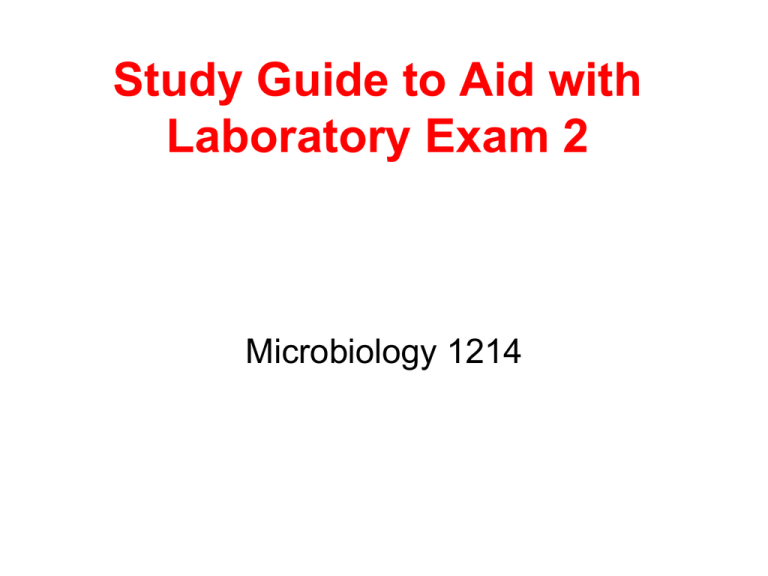Specimens
advertisement

Study Guide to Aid with Laboratory Exam 2 Microbiology 1214 We will innoculate this media with soil in an effort to grow out anaerobic spores. Name this media. Is it enrichment or selective media? Identify this organism. Name the subphylum to which it belongs. Name the kingdom. What method of movement does this organism use? Identify this organism. What is the genus name? What is the subdivision? What is the kingdom? Name this organism. What two organisms compose it? What are their functions? Identify the growth form. Identify this organism. What subdivision of fungi does it belong to? Does an anaerobic or aerobic bacterium test positive for catalase? What reagent is used when performing the catalase reaction? Name the genus of this organism. What dye is normally used to view it? Identify the structures marked by the arrows (3). What is the genus? Identify the organism by its genus name. What is its division? What is its kingdom? Name the genus of the organism. What method of reproduction is being used? What is the proper name for a bud? Identify the organism. What kingdom is it in? What sexual process does this organism use for reproduction? Identify the organism. What division does this organism belong to? Identify this organism. What kingdom does it belong to? Name the structure indicated by the arrow. What is its purpose? Identify the type of spores pictured. Do they indicate sexual or asexual reproduction? Give the common name of these organisms. What is their division? What is their subkingdom? What is their kingdom? Give the genus name of the organism at the tip of the pointer. Name the phylum to which this organism belongs. What disease does it cause? What is the vector? What is this container called? What is the catalyst involved in the reaction? What does the envelope containing sodium bicarbonate and sodium borohydride do? Name a disease caused by an anaerobic bacteria. Name the genus of the fungus pictured. (Hint: It is the same organism we looked at in class under the dissecting microscope.) What subdivision does it belong to? Identify the organism. What division does this organism belong to? Identify the plate below that is countable? What are the reference numbers associated with a countable plate? A B C What genus does this organism belong to? What fungal subdivision does it belong to? Rhizopus. Classify the organism. What type of reproduction is pictured? Classify. Identify. What type of reproduction is occurring? Identify the organism pictured here. Identify the disease indicated by this blood smear. What kingdom of organism caused the disease? What subkingdom of organism caused the disease? Identify the individual strands pictured. What is a mass of these strands called? Define obligate aerobe, facultatative anaerobe, obligate anaerobe, aerotolerant anaerobe? Be able to calculate the dilution of tubes and plates. What type of bacteriophage has the ability to destroy cells and create plaques? What are the clear areas called? What do they indicate? What is the name for this set up? What type organism might we grow out on a set up such as this? What type growth is observed in the specimen growing on the wood below. Identify the growth type of lichen pictured on the rock below. Identify the growth type for this lichen. What lichen growth type is pictured below? What is the common name for the class trematoda? What organ is usually infected with this organism? What is the common name for the class Cestoda? What is the only cestode capable of completing its life cycle without an intermediat e host? A, B: The eggs are rounded, diameter 31 to 43 µm, with a thick radially striated brown shell.The egg in Figure B still has the primary membrane that surrounds eggs in the proglottids. Identify the genus of the organism that produces the egg pictured above. What phylum does it belong to? Name two animals that generally are infected with worms of this genus. What is the common name of the most common worm infection in the United States? What is the scientific name? Catalase Test on Streptococcus lactis . How would you report out these results? Which gives a positive reaction…aerobes or anaerobes?








